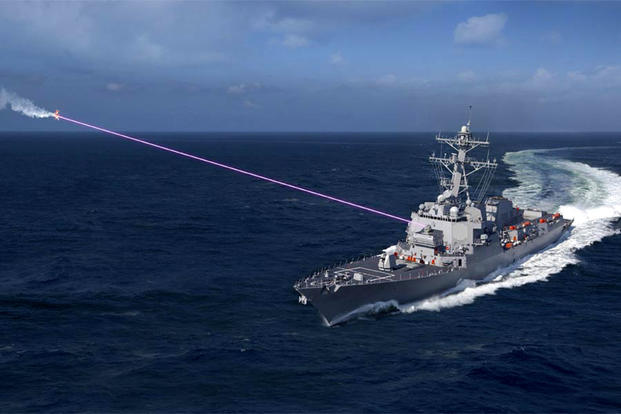The Navy has awarded an initial $150 million contract to Lockheed Martin to develop shipboard lasers that can "dazzle" enemy drone swarms and take out small boats.
It's a "watershed moment" in the Navy's decades-long effort to develop laser weapons for surface ships, Ian McKennie, Lockheed's business development leader for laser systems, said Friday of the $150 million contract that could go to $942.8 million with options.
Lockheed plans to deliver two of the systems to the Navy in fiscal 2020. One would go on board an Arleigh Burke-class destroyer for testing and the second would be used for land testing at the White Sands Missile Range in New Mexico.
"Our design is scalable, and we can optimize it to meet requirements for future increments," Dr. Rob Afzal, a Lockheed senior fellow of laser weapon systems, said of the system called HELIOS, for High Energy Laser and Integrated Optical-dazzler with Surveillance.
"The HELIOS program is the first of its kind," said Michele Evans, vice president and general manager of Integrated Warfare Systems and Sensors at Lockheed.
HELIOS, she said, "brings together laser weapon, long-range [Intelligence Surveillance and Reconnaissance] and counter-[Unmanned Aerial System] capabilities, dramatically increasing the situational awareness and layered defense options available to the U.S. Navy."
"The primary targets are small boats and, even more importantly, small drones," McKennie said in a phone conference. He was reluctant to go into the classified specifics of the "dazzling" effects of HELIOS, but said the system was designed to "confuse or limit the capability" of enemy drones targeting Navy ships.
McKennie said the system was designed to be placed forward on the ship and be integrated with Aegis Combat Systems on board the destroyers, but he could not give an estimate on when HELIOS would be operational.
The Navy has experimented for decades with directed energy weapons and most recently placed an XN-1 LaWS (Laser Weapons System) ships' defense system on board the USS Ponce in 2014 for field testing.
The Ponce, an Austin-class amphibious transport dock, at the time was being used to test the Navy's Afloat Forward Staging Base concept, in which the ship would serve as a weapons platform and a base for Special Operations troops and Army attack helicopters. The Ponce has since been decommissioned.
McKennnie said the HELIOS program drew on data and lessons learned from the LaWS testing, which was combined with Lockheed's own work on lasers and experience with Aegis systems to come up with HELIOS.
-- Richard Sisk can be reached at Richard.Sisk@Military.com.












